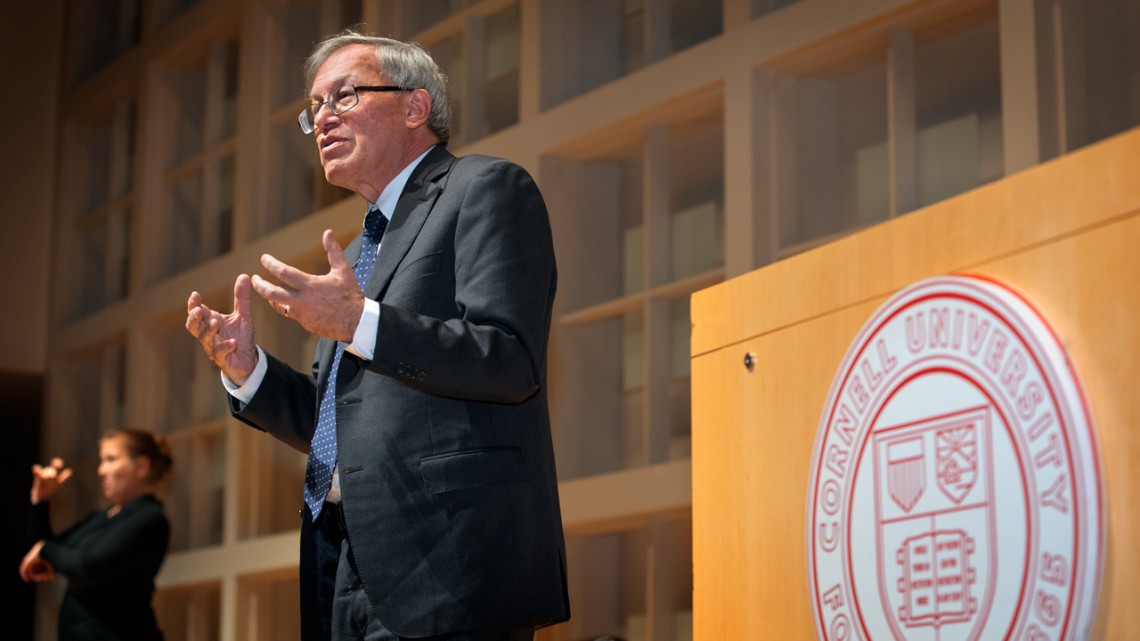
Constitutional law scholar Erwin Chemerinsky addresses the topic of free speech on campus Nov. 20 in Alice Statler Auditorium. At left, Lisa Witchey translates the lecture for the hearing impaired.
Legal scholar: Campuses must protect free speech – even hate speech
By Susan Kelley
Colleges and universities must create supportive academic environments for all students while also upholding free speech – even if that speech includes hateful ideologies, says a renowned legal scholar.
“I strongly feel that colleges and universities have the duty to be an inclusive environment for all students, but I don’t think that can be achieved by censoring speech,” said constitutional scholar Erwin Chemerinsky, dean of Berkeley Law at the University of California, who spoke Nov. 20 in Alice Statler Auditorium.
Chemerinsky’s talk was the first event of the Free Speech Presidential Speaker Series, initiated by President Martha E. Pollack to address campus climate. The series is co-sponsored by the Cornell Law School.
Eduardo Peñalver ’94, the Allan R. Tessler Dean of Cornell Law School, introduced Chemerinsky and moderated a Q&A after his lecture.
Students in the 1960s advocated for their right to speak freely, Chemerinsky said, whereas today free speech issues often arise when outside speakers come to campuses, sometimes to communicate an offensive agenda.
The current law says all ideas and views can be expressed on public university campuses. “Even if it’s very offensive speech, it’s still protected by the First Amendment,” he said. The amendment does not apply to private universities – although Chemerinsky thinks they should also follow the principle, he said.
The law also says free speech is not absolute. Unprotected speech, which includes child pornography and false advertising, comes in three forms: incitement, “true threats” and harassment. Universities can punish any of them, Chemerinsky said.
Incitement means a speaker explicitly advocates illegal activity, such as encouraging her audience to vandalize a building. “True threats” cause a person to fear imminent, physical danger, such as when a student walking across campus is menaced by an angry mob.
Although the courts haven’t clearly defined harassment on campus, workplace precedents can be applied, he said. Speech that creates a hostile environment or is directed at a specific person is harassment. Although vile, a noose hanging from a tree on campus wouldn’t count, but a noose hanging from the dorm-room door of an African-American student would, he said.
The law also says universities may restrict the time, place and manner in which someone speaks. For example, they can require a person speak in an auditorium, where it’s easier to provide security, rather than at an open-air venue.
Many scholars argue hate speech should not be protected, especially when it threatens minority students. Chemerinsky disagrees, he said. “The law is clear: Hate speech is protected by the First Amendment.” For example, in 1977 the Supreme Court ruled the Nazi Party had the right to march in Skokie, Illinois, even though most of the residents of that town were Jews and Holocaust survivors.
And in the 1990s, more than 350 universities and colleges adopted so-called hate-speech codes. However, Chemerinsky said, “Every one to be challenged in court without exception was declared unconstitutional.”
Why is vile speech protected? In part because hate speech is hard to define in legal terms, he said. He cited the University of Michigan’s now-defunct hate speech prohibition as an example; every action enforcing it was brought against African-American and Latino students – the very individuals the prohibition was meant to protect, Chemerinsky said.
Can students legally drown out a speaker with whom they disagree? No, he said. The right to free speech does not include the right to disrupt the speech of others. “Otherwise there would always be a heckler’s veto,” he said. “The only speech then we would ever hear is that which is sufficiently noncontroversial that no one wants to stop it.”
Universities must struggle, though, with how much they’re willing to spend to ensure campus safety. “What if it cost us $20 million? There’s got to be a point where universities say, ‘We can’t afford it.’” Administrators must also understand that if banned, controversial speakers may sue the university and are likely to win, he added.
The most difficult free speech issues involve social media and the internet. In these instances, the speech is not physically located on campus but can have an enormous effect there. When should a university be able to punish or prevent the use of the internet to reveal sexually explicit photos or private information – so-called “doxing” – such as that someone is transgender or undocumented? The answer is unclear, he said: “The law just hasn’t kept up with the technology.”
History has shown restricting viewpoints on campus can be a dangerous practice, he said. In the 1950s, many universities tried to fire professors for allegedly being Communists. In the 1960s, professors and students were frequently censured for their anti-war and civil rights protests.
“The First Amendment is ultimately based on a faith that we’re better off allowing all ideas to be expressed than [allowing] our government officials to punish some of them,” Chemerinsky said. “I have to say I generally share that faith, but I also have some doubts too.”
Media Contact
Get Cornell news delivered right to your inbox.
Subscribe